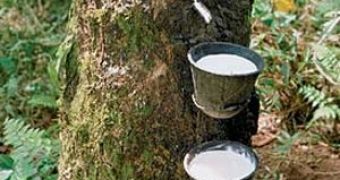The soles of your sport shoes may be made of natural rubber. And maybe also the down part of your carpet and furniture, the band of your clothes, your rain coat, and your gumboots.
Going to swim? Swimming suits, water glasses and diver flippers are made of rubber.
Or you just prefer lying on a gum raft or play with a gum ball. Your sleeping pillow and mattress may be made of rubber. Many products wouldn't work without rubber pieces: washers, belts, valves, gaskets, hoses and so on. A car contains about 600 rubber pieces and the total number of rubber pieces is about 40,000-50,000.
Why is rubber so useful? Because it has durability, water and warm resistance, it's elastic, hermetic and adsorbs chokes. If we look at a tire: it does not damage easily at the contact with the road, and there's no fire at its continuous contact with the road. It does not soak or oxidate; it does not allow the air to go out. And it also reduces chokes because of its amortization capacity. There couldn't be cars without tires.
Rubber can be natural - obtained from rubber trees - or synthetic, made of oil. They have different advantages and disadvantages and usually, a mix of both is used. As natural rubber is more resistant to high temperatures, it's more used in making tires for race cars, trucks, buses and planes.
Natural rubber is obtained from a tropical tree, Hevea brasiliensis, originating in the Amazon Basin, which can be 30 m (90 feet) tall. Now, most rubber production comes from Southeast Asia (Malaysia and Indonesia), the rest from South America, west/central Africa. When the tree reaches the 6th year, it enters in rubber production. It will produce rubber for the next 25-30 years, when it has reached 20 m, and after that, the tree "retires", keeping on growing, and it can live over 100 years. The wood is very appreciated for furniture.
Fresh rubber looks like milk and it's called latex. 35 % of the latex is made of tiny particles of rubber; the rest is water. The latex is obtained by notching orthogonally the tree's bark with a knife. The cut stretches over half of the tree's circumference. A cut too wide would harm the tree.
The latex starts pouring in a moment; it oozes along the groove into special cups attached to the trees. Pouring lasts for two-three hours and then it stops. After one-two days, another cut can be made a little lower on the tree. The next will be lower and so on. In time, the cuts will look like a little panel. At that moment, another part of the tree will be notched, letting the panel heal completely for a further exploitation in the future.
In the collected latex formic acid and water are added. This process hardens and coagulates it, making it look like yoghurt. In rubber mills, the water is removed and the rubber is vulcanized (with sulfur) and ready to be molded in what is needed further. Worldwide, 5 million tonnes of natural rubber are produced annually.

 14 DAY TRIAL //
14 DAY TRIAL //